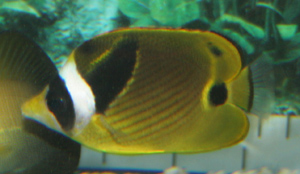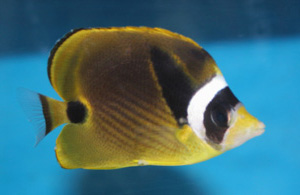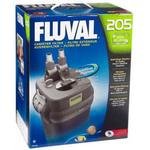Raccoon Butterflyfish – Chaetodon lunula
The raccoon butterflyfish comes from the Indo-Pacific ocean region. The raccoon is not a fish for people wanting a reef tank. It will attack and eat many corals and invertebrates. This fish like many other butterflyfish needs high water quality. 
Maximum Size: The raccoon butterflyfish should grow to a maximum size of 8.0 inches
Minimum Tank Size: The minimum tank size should be 75 gallons
Care Level: The raccoon butterflyfish is a moderate level fish. On a scale of 1 –10, (10 being easy) it would rate a “7”. The tank should already be cycled and considered mature.
Tank Conditions: Temperature 77-79°F; Specific gravity: 1.021 – 1.024; pH: 8.1 – 8.3; Nitrates should be no more than 10 ppm.
Color: The raccoon butterflyfish – as picture shows is a subdued coloration. It is generally yellow in color with a black band over its eyes (like its namesake) followed by a white band. It has a slightly extended snout.
Temperament: This is a good fish. It is one of the few saltwater fish that may be able to live with others of its kind in the same tank.
 Reef Compatible: May eat at and possibly destroy hard and soft corals as well as invertebrates, anemones. If put into a reef tank – take care. It will attack and kill anemones – and it has been written that if a new raccoon will not eat it may be prodded to by introducing an anemone for it to nip at. Reef Compatible: May eat at and possibly destroy hard and soft corals as well as invertebrates, anemones. If put into a reef tank – take care. It will attack and kill anemones – and it has been written that if a new raccoon will not eat it may be prodded to by introducing an anemone for it to nip at.
Diet: The raccoon butterflyfish is an basically a carnivore. Typical meaty foods such as brine shrimp, clams, fish meat etc that can be purchased from your local store should be provided.
Habitat: Provide with plenty of hiding places. Good water circulation is important as well as high quality water maintenance. Filtration should include a protein skimmer and activated carbon filtration.
Lighting: Medium to bright lighting
Compatibility: Butterflyfish in general can be kept with cardinalfish, catfish, filefish, firefish, gobies, grammas, rabbitfish to name a few and they should not be housed with groupers, sharks, lionfish or rays and can be a problem if housed with damselfish, basslets, surgeonfish, triggerfish and certain wrasses.
|





 Reef Compatible: May eat at and possibly destroy hard and soft corals as well as invertebrates, anemones. If put into a reef tank – take care. It will attack and kill anemones – and it has been written that if a new raccoon will not eat it may be prodded to by introducing an anemone for it to nip at.
Reef Compatible: May eat at and possibly destroy hard and soft corals as well as invertebrates, anemones. If put into a reef tank – take care. It will attack and kill anemones – and it has been written that if a new raccoon will not eat it may be prodded to by introducing an anemone for it to nip at.